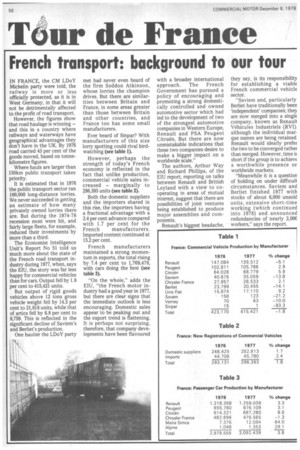French transport: background to our tour
Page 58

If you've noticed an error in this article please click here to report it so we can fix it.
IN FRANCE, the CM LDoY Michelin party were told, the railway is more or less officially protected, as it is in West Germany, in that it will not be detrimentally affected to the profit of road transport.
However, the figures show that road haulage is winning and this in a country where railways and waterways have geographical advantages they don't have in the UK. By 1976 road carried 43 per cent of the goods moved, based on tonnekilometre figures.
Where hauls are larger than 150km public transport takes priority.
It is estimated that in 1976 the public transport sector ran 100,000 long-distance lorries. We never succeeded in getting an estimate of how many privately owned lorries there are. But during the 1974-78 recession most were hit, and fairly large fleets, for example, reduced their investments by more than a third.
The Economist Intelligence Unit's Report No 51 told us much more about the state of the French road transport industry during 1977, when, says the EIU, the story was far less happy for commercial vehicles than for cars. Output fell by 1.8 per cent to 415,421 units.
But output of rigid goods vehicles above 12 tons gross vehicle weight fell by 14.3 per cent to 21,818 units, while that of artics fell by 6.8 per cent to 9,759. This is reflected in the significant decline of Saviem's and Berliet's production.
One haulier the LDoY party met had never even heard of the firm Seddon Atkinson, whose lorries the champion drives. But there are similarities between Britain and France, in some areas greater than those between Britain and other countries, and France too has some small manufacturers.
Ever heard of Sinpar? With manufacturers of this size lorry spotting could rival birdwatching (see table 1).
However, perhaps the strength of today's French economy is reflected in the fact that unlike production, commercial vehicle sales increased marginally to 298,393 units (see table 2).
Both the domestic suppliers and the importers shared in this rise, the importers having a fractional advantage with a 2.4 per cent advance compared with 1.7 per cent for the French manufacturers. Imported content continued at 15.2 per cent.
French manufacturers maintained a strong momentum in exports, the total rising by 7.4 per cent to 1,769,478, with cars doing the best (see table 3).
"On the whole," adds the EIU, "the French motor industry had a good year in 1977, but there are clear signs that the immediate outlook is less encouraging. Domestic sales appear to be peaking out and the export trend is flattening. It is perhaps not surprising, therefore, that company developments have been flavoured with a broader international approach. The French Government has pursued a policy of encouraging and promoting a strong domestically controlled and owned automotive sector which had led to the development of two of the strongest automotive companies in Western Europe, Renault and PSA Peugeot Citroen. But there are now unmistakable indications that these two companies desire to make a bigger impact on a worldwide scale."
The authors, Arthur Way and Richard Phillips, of the EIU report, reporting on talks between Renault and British Leyland with a view to cooperating in areas of mutual interest, suggest that there are possibilities of joint ventures being established to produce major assemblies and components.
Renault's biggest headache, they say, is its responsibility for establishing a viable French commercial vehicle sector.
"Saviem and, particularly Berliet have traditionally been 'independent' companies; they are now merged into a single company, known as Renault Whicules Industriels (RVI) although the individual marque names are being retained Renault would ideally prefel the two to be converged rathei than merged. However, time short if the group is to achieve a worthwhile presence or worldwide markets.
"Meanwhile it is a question of holding on under difficult circumstances. Saviem and Berliet finished 1977 with stocks of about 6,000 unsold units, extensive short-time working (which continued into 1978) and announced redundancies of nearly 2,000 workers," says the report.
































































































































